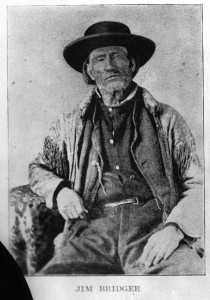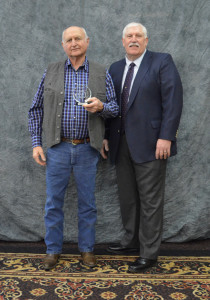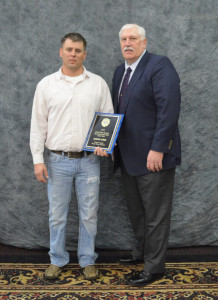Ashley Curtis of Winner has been named to the fall semester dean’s list at the University of South Dakota. She has been accepted into the graduate school in speech language pathology.
Curtis is working on her master’s degree.
Ashley Curtis of Winner has been named to the fall semester dean’s list at the University of South Dakota. She has been accepted into the graduate school in speech language pathology.
Curtis is working on her master’s degree.

His eyes rolled wildly in his head. His teeth chattered. He broke out in a clammy sweat. Hugh Glass, the man he had left for dead, was standing before him. Was Glass going to end his life? No.
Jim Bridger’s life was spared.
So goes P. St. George Cook’s version of the legend surrounding Glass. The film “The Revenant” starring Leonardo DiCaprio has rekindled interest in Glass’ crawl through northwestern South Dakota and into history.
In August 1823, Glass and Bridger were among a small group of trappers heading west overland to the Yellowstone River by way of the Grand River in present-day South Dakota. About 12-miles south of present-day Lemmon, Glass was severely mauled by a grizzly bear. Glass survived and began crawling toward the nearest settlement, Fort Kiowa, nearly 200 miles away.
According to legend, Bridger and John Fitzgerald were to stay with Glass until he died, but they abandoned him. When Glass regained consciousness he found himself alone on the prairie without a gun or other equipment. He vowed revenge against the men who had left him for dead.
Glass is said to have found Bridger and forgiven him. In sparing Bridger, Glass spared the life of a man who would become one of the most important fur trappers and guides in the American West. The Rev. Pierre Jean De Smet, the Belgian-born Jesuit missionary after whom the South Dakota town is named, described Bridger as “one of the truest specimens of a real trapper and Rocky mountain man.”
De Smet and Bridger first met in 1838, and became lifelong friends, according to Charles Edmund DeLand in Volume XI of “South Dakota Historical Collections,” compiled by the South Dakota State Historical Society.
Bridger came to the Upper Great Plains in 1822 when he answered an advertisement in the Missouri Republican seeking 100 enterprising young men to travel the Missouri River to its source. Bridger worked for various fur trading companies for the next 20 years, roaming the western third of the United States. He is credited with being the first non-Indian to report reaching the Great Salt Lake.
“There was scarcely an accessible spot in the mountains that he was not acquainted with,” wrote DeLand. “He had become a daring leader before 1830 and in that year was one of the partners of the newly organized firm of the Rocky Mountain Fur Company. He led his expeditions in every direction, saw many a fight with the Indians.”
With Louis Vasquez, Bridger established Fort Bridger in southwest Wyoming in 1843. The fort became one of the main trading posts for those headed west on the California and Oregon trails.
Bridger was also in constant demand as a guide to military expeditions. One military expedition would take Bridger back through South Dakota, as he guided for Capt. William Raynolds in an exploration of the headwaters of the Yellowstone and Missouri rivers. The expedition left St. Louis on May 28, 1859, and traveled on the Missouri River until disembarking at Fort Pierre to travel overland.
Bridger proved to be overcautious and inaccurate as a guide until he reached familiar country in the Yellowstone River region, according to an article in Volume 5 of “South Dakota History.”
Bridger claimed in an article in the Cheyenne Daily Leader that he discovered gold in the Black Hills while with the Raynolds expedition, but according to the “South Dakota History” article, Bridger’s claims had to be measured against the fact that the interview took place after the 1874 Custer Expedition’s report of gold received national publicity.
In 1868, Bridger retired to his farm in Missouri, where he died on July 17, 1881. In “Mountain Men and the Fur Trade,” Aubrey L. Haines states that Glass never named the men left to care for him after the grizzly’s attack. Fellow trapper James Stevenson wrote that Bridger told him the story of Glass being mauled by a grizzly, but Bridger never said he deserted Glass.
After his encounter with the grizzly, Glass survived several more brushes with death. His luck ran out during the winter of 1832-1833, when he and two companions were killed by Indians as they crossed the Yellowstone River. A new biography about Glass, “Hugh Glass: Grizzly Survivor,” by historian James D. McLaird will be released by the South Dakota Historical Society Press this spring. This moment in South Dakota history is provided by the South Dakota Historical Society Foundation, the nonprofit fundraising partner of the South Dakota State Historical Society at the Cultural Heritage Center in Pierre. Find us on the web at www.sdhsf.org. Contact us at info@sdhsf.org to submit a story idea.

The South Dakota Association of Rural Water Systems (SDARWS) has awarded Ray Bartels, longtime director of the Tripp County Water User District with the Spirit of Rural Water Award on January 14, 2016 during their Annual Technical Conference.
The Spirit of Rural Water Award recognizes people, businesses, or groups who go above and beyond for a rural water system or rural water cause in South Dakota.
The South Dakota Association of Rural Water Systems mission is to “provide the highest quality services that meet the needs of and supports the collective efforts of our water and wastewater membership. SDARWS is dedicated to improving and maintaining the water of South Dakota by providing technical assistance, certification classes and many training events held throughout the year.
The South Dakota Rural Water Annual Technical Conference in Pierre annually hosts over 450 individuals and provides water and wastewater educational presentations for board members, managers, and operations specialists from throughout South Dakota.

The South Dakota Association of Rural Water Systems (SDARWS) recently named Tripp County WUD System Operations Specialist Jason Orel as the top Rural Water System Operations Specialist during the organization’s Annual Technical Conference in Pierre.
“Jason is a great asset to our water system and he goes above and beyond using a common sense approach in his day to day duties,” said Tripp County WUD Manager Russ Phillips. “Jason has come to know our large geographical system, which encompasses 2500 miles of pipe stretching into five counties and 2519 customers. We at Tripp County Water User District feel very lucky to have an operator such as Jason on our work force and are proud to see him receive Operator of the Year.”
Orel holds certifications in Class II Water Distribution, Class I Water Treatment,
Class I Wastewater Collection, and Class I Stabilization Pond.
Orel was born and raised in Winner. He was very active in many sports throughout his school years, but excelled in wrestling. He was a three time state wrestling runner-up and graduated from Winner High School in May 2003.
Tripp County Water Users District is located in Winner and serves the counties of Tripp, Gregory, portions of Lyman, Mellette and Todd, individually serves the towns of Witten, Wood, Herrick, Fairfax, and St. Charles, and bulk serves the towns of Colome, Dallas, Burke, Bonesteel, six Native American communities.
The South Dakota Rural Water Annual Technical Conference in Pierre annually hosts over 450 individuals and provides water and wastewater educational presentations for board members, managers, and operations specialists from throughout South Dakota.
PIERRE, S.D. – GED Testing Services (GEDTS) has announced a recalibration to the GED Test passing score and the addition of two new performance levels.
The passing score for high school equivalency is moving from 150 to 145. The program will also include two optional levels above high school equivalency to signify college readiness.
South Dakota will retroactively apply the new performance levels to test-takers who have tested since Jan. 1, 2014. Students who earn scores between 145-149 prior to the new passing score will be eligible for this high school equivalency credential.
In addition to the 545 South Dakota students who earned a credential since Jan. 1, 2014, an estimated additional 78 will be awarded the credential due to the change in cut score.
GEDTS will notify affected students. All students can expect to see their updated scores and information in their MyGED account on March 1.
The scoring enhancement is a result of detailed analysis of educational outcomes of GED program graduates compared to high school graduates over the past 18 months. The outcomes data show GED graduates are performing as well as, and in many instances outperforming, high school graduates in terms of not needing remediation when entering postsecondary programs.
By Dana Hess, Community News Service
PIERRE — With just 20 members in the Legislature—eight in the Senate and 12 in the House—Democrats face constant rejection of the bills they offer. However, being a super-minority can have its benefits said Democratic legislative leaders when they spoke to publishers, editors and reporters at South Dakota Newspaper Association’s Newspaper Day on Thursday.
House Minority Leader Spencer Hawley, D-Brookings, said Democratic legislators needed to make their decision to run for re-election during the session rather than after. “We literally are totally beat down” by the end of the session, Hawley said.
“Even as a super-minority, we have had a huge impact on South Dakota,” said Senate Minority Leader Billie Sutton, Burke.
Sutton noted Democratic support for successful initiated measures in recent elections, including the boost in the state’s minimum wage. He said bills brought by Democrats are routinely defeated, only to return in a slightly different form at a later session as a Republican-sponsored bill.
“I’m fine with that,” Sutton said, as long as good bills are working their way through the Legislature.
Sutton pointed to the ongoing discussion in the current legislative session about Gov. Dennis Daugaard’s proposed half-cent sales tax increase as a funding source to raise teacher pay.
“Guess who’s been banging the drum on that for five years,” Sutton said. “We’re actually the ones fighting for what you want.”
Hawley noted how happy Democrats are to be talking about education funding and the governor’s plan to increase Medicaid.
“We probably agree on more of it than his own party does,” Hawley said.
Political parties in the Legislature traditionally caucus so leaders can direct members on how they want them to vote on certain legislation. South Dakota’s Democrats caucus, but the leaders don’t try to sway their members, according to Hawley.
“We end our caucus with ‘vote your conscience,’” Hawley said.
Bringing the Democratic Party out of super minority status may rely on a constitutional amendment that will be on the 2016 ballot. The measure would take redistricting of legislative districts away from the Legislature and give it to a special commission.
Hawley said the general public should choose how the districts are formed rather than allowing the Legislature to do it. He said this results in legislators choosing their own districts.
“It needs to be a totally separate entity,” Hawley said, “a bi-partisan panel.”
Dayna Diez of Winner has been named to the fall semester dean’s list at the University of Sioux Falls. She is a senior majoring in nursing.
Haley DeMers of Winner was also named to the dean’s list at USF. She is also a nursing major.
Tumbling crude oil prices around the world have helped send the South Dakota retail average price for gasoline to $1.86 per gallon, nine cents lower than the price a year ago and 12 cents below the price one month ago, AAA reports. The price average in Rapid City is 47 cents more than the price in Sioux Falls.
“Crude oil’s in free fall amid plentiful supplies, increased exports from Iran, and concerns that problems in the Chinese economy will reduce fuel demand,” said Marilyn Buskohl, spokeswoman for AAA South Dakota. “These low gas prices are making driving more affordable, incentivizing motorists to hit the highway and take a good-fashioned American road trip, weather permitting.”
National retail gas price averages have fallen for 63 of the past 74 days, for a total savings of 34 cents per gallon, reaching today’s price of $1.88 per gallon. Gas prices are down seven cents per gallon on the week, which is the fastest pace gas prices have dropped since the middle of November. Motorists typically enjoy falling gasoline prices in early winter due to decreased demand for gasoline and that also is helping to push prices downwards. Despite recent declines, the national average price of gas is only 18 cents per gallon cheaper than a year ago since prices also were very low in early 2015.
Sarah Calhoon of Ideal has been named to the fall semester dean’s list at South Dakota State University. Calhoon is in the pharmacy school.
Sarah Shippy of Colome was named to the fall semester dean’s list at the University of South Dakota.